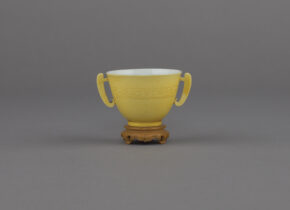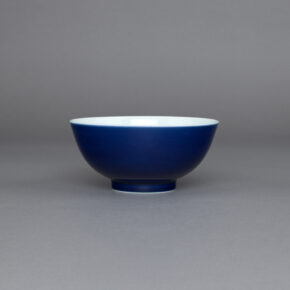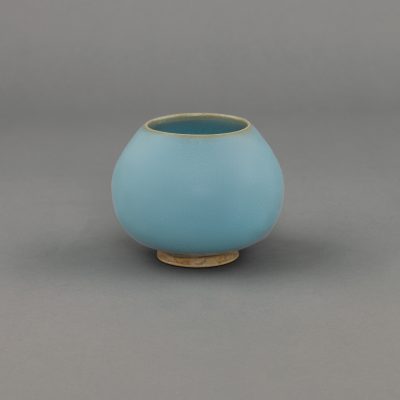


Monochromes
From the Greek monokhromos, mono – one, khromos – colour, Chinese monochrome porcelain is considered to be one of the ceramic world’s great achievements.
Chinese monochrome porcelain is said to have its roots in the Song dynasty (960 – 1279). At the turn of the first millennium, China was the world’s most advanced civilisation and this epoch is known for the invention of movable type printing, bank notes, gunpowder, the compass and even the concept of the restaurant.
Early Chinese monochromes were black and white but very quickly, competition emerged. Kilns vied with each other to see who could make the most exquisite pieces of monochrome Chinese porcelain. In the Song dynasty, the emergence of Ge ware, Guan ware, Ru ware and Jun ware enabled a new burst of colour to appear within the ceramic production.
As the Song dynasty made way for the Yuan, dramatic advancements in the production of Chinese monochrome vases and indeed all forms of Chinese monochromes were developed.
While the production of monochrome Chinese porcelain continued throughout the Yuan dynasty, the Ming dynasty was when new glazing techniques were established. In the Ming dynasty, the most popular monochrome colours used by the imperial court were yellow, red and blue.
When the Qing dynasty arrived, monochromes were very much loved by the emperor and the court. New innovations within the Qing dynasty saw the arrival of new glazes such as peachbloom, teadust, robin’s egg, celadon and lavender, with Song-inspired glazes re-emerging such as Ge, Guan and Ru ware. Further development of enamelled glazes produced remarkable colours not seen before, such as pink, ruby, lemon-yellow, pale turquoise and lime-green.
-

19. M5364
£1,800Chinese turquoise glazed biscuit porcelain water-dropper in the form of a fish above waves, with naturalistic scales and raised tail, covered in a bright turquoise glaze.
-

23. M5356
£3,200Chinese turquoise glazed biscuit porcelain joss-stick holder in the form of the He He Erxian, both seated and smiling with their arms around each other, one holding a box, the other a floral branch and exposing their corpulent bellies protruding from their robes, above a singular circular joss-stick holder, with unglazed base.
-

29. M4751
£9,500Chinese ceramic green glazed monochrome pillow, zhen, of ruyi-head form, incised on the gently concave top with outlines following the form, with further incised lines beneath the sloping shoulder, the fluted body covered overall in a rich and even deep apple green glaze, the flat predominantly unglazed base revealing the buff-coloured body, with an air hole from the firing beneath the ruyi-head point.
-

37. M5212
£POAChinese ceramic Jun ware lotus-bud form waterpot, jixin’guan, covered overall with a rich and even lustrous lavender sky-blue glaze, extending overall to the interior and the base thinning towards the light brown rim, all on a slightly splayed short unglazed brown knife-cut foot rim.
-

M4942
£22,500Pair of Chinese celadon glazed small vases and covers of guan form, each carved with flowerheads on a continuous scrolling branch amongst leaves above a wide lappet band with upright leaves and further flowerheads and scrolls on the shoulder, and beneath a triangular band on the gently flared neck, the covers with central raised flowerhead, again above a scrolling flowerhead band, the base glazed, the unglazed foot rim, rim and underside of the cover revealing the biscuit body.
Further information on Monochromes
Chinese monochromes took a starring role in state ceremonies because traditional Chinese beliefs assumed that ritual vessels must be Chinese monochromes of glazed porcelain of particular colours, representative of four temples in Beijing and the gods they represented:
Blue Chinese monochrome porcelain – Altar of Heaven (tiantan)
Yellow Chinese monochrome porcelain – Altar of the Earth (ditan)
White Chinese monochrome porcelain – Altar of the Moon (yuetan)
Red Chinese monochrome porcelain – Altar of the Sun (ritan)
The reign of Kangxi at the start of the Qing dynasty was when the techniques of Chinese monochromes began to mature.
The beauty of Chinese monochrome vases, indeed all Chinese monochrome porcelain was in the technical accomplishment, the finesse of the colours and the quality of the glaze. It’s testament to the processes developed to produce monochrome Chinese porcelain that the colours have remained as spectacular as they were the day they were fired.
Arguably the most famous of all the colours, not just of Chinese monochrome porcelain but of all Chinese porcelain, blue is almost infinitely varied and the cobalt used came from as far away as modern-day Iran – from the most pale clair de lune to the deepest shades known as Mazarine blue.
You should also check

Chinese Ceramics From Tang to Song
Chinese Ceramics Tang to Song coincides with the 25th anniversary of Asian Art in London. The exhibition has been carefully curated and includes 43 pieces with excellent provenance, many of which are the finest examples of their type that the gallery has ever handled in almost 100 years of business.










